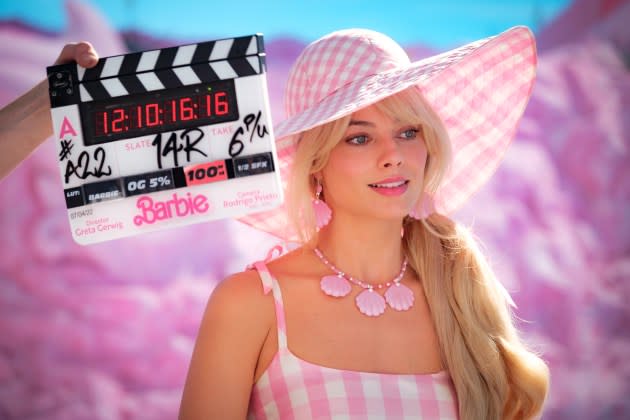Greta Gerwig Looked at Hundreds of Birkenstocks for ‘Barbie’ Before Finding the Perfect Rose Pink

When Greta Gerwig worked with costume designer Jacqueline Durran on “Little Women,” the pair went on a trip to a building in London’s Docklands to draw inspiration for the adaptation.
“There were old file cabinets labeled ‘British Gardens 1830-1835′ and things you couldn’t find anywhere,” Gerwig recalls. “There were out-of-print books and original frames for making corsets and hoop skirts.”
More from Variety
A few years later, the director would turn to Durran to help bring the aesthetic of “Barbie” to life. She didn’t think Durran would want to collaborate again. “I almost killed her on that,” Gerwig jokes about the 200-plus costume changes that took place in that film. But Durran, who hadn’t had the chance to work on many projects in America, said yes. And it became their biggest collaboration to date. “Barbie is all about the clothes, and it was daunting,” says Gerwig.
Here they discuss that collaborative process, how Barbie’s looks evolved and reveal how they found the perfect Birkenstock sandal for Margot Robbie’s Barbie.
How did the costume process evolve?
DURRAN: When we started, we didn’t have rules for the world yet. Even the idea that we’d be grounded in the history of Mattel, rather than just fashion, was not something that was a given. That evolved because Greta had written the starting point of 1959, so it became an idea that that’s what we could do costume-wise. There were so many things to work out. There was a world where the clothes could have been ugly like big velcro stick-on clothes. So, it took a lot of conversation.
GERWIG: She’s a doll. The proportions, sizes and even the way the pattern worked – you wouldn’t have a tiny pattern on a doll, you’d have a bigger pattern – so it was a puzzle that needed to be figured out. Not one thing in any frame didn’t have hours of meetings behind it.
Given the pressure, was there an outfit or scene that you saw and felt, ‘We can do this’?
GERWIG: We shot the wake-up sequence the first week. It was almost like a silent film because it was her going through her day. It was like a ballet. Everyone looked so great and perfect. You could see her neighbor, her floating into her car, the jogger and the milkwoman. It felt exactly how I wanted it to feel. Jacqueline always says, “A Barbie doesn’t dress for the day, she dresses for the activity,” and it felt delightful.
DURRAN: It’s not just Margot walking through. It’s every Barbie.
Which scene required the most work costume-wise?
GERWIG: The beach costumes. I didn’t want them in string bikinis. I wanted something more 1950s or 1920s bathing costumes.
DURRAN: In the art department, they had boards and boards of reference. They had 1950s photographs of groups of women playing on the beach. What was interesting was groups of women playing with beach balls. They were nostalgic and had an innocence about them. It was groups of women doing things on the beach and it wasn’t objectified in any way.
What about the use of Birkenstock sandals, when did that come in?
GERWIG: I will have it be known, that the Birkenstocks was not product placement. We just wanted Birkenstocks.
DURRAN: Greta wrote that.
GERWIG: It was always that. When she first holds the shoe up, it’s the classic suede version. As she becomes more human, there are a lot of things — the clothes, the fabrics, the patterns, and even the jewelry become more delicate. That’s something Margot and Jacqueline did. But the Birkenstock at the end shows how Barbie changes from beginning to end. We wanted it to be pink because she’s still Barbie. We looked at the bright pink one. There were hundreds, and this one (the Arizona Big Buckle Nubuck Vegan Leather Birkenstocks in Rose) was subtle. It felt sweet, charming and perfect. Anything on screen, I feel we looked at 100 versions of.
DURRAN: Kate McKinnon was so great with that Birkenstock option in the scene. Weird Barbie is a great example of how the process worked. Kate came up with the idea that Weird Barbie is a mess from the bottom of the box, but Greta said, “No, she needs to look like something.” So, that was an evolution in the idea of Weird Barbie.
GERWIG: It was figuring out if there was decay in Barbieland. Are things dirty? And then we were like, “No, it’s not decay.” It can be odd and mixed up and yet is somehow in the eternal present of being pristine even though her face is drawn on and her hair is cut off. The example I used, and I don’t know if this is true, but I believed it was — this idea of space trash. If you throw a burger out into space, the wrapper wouldn’t decay because there’s nothing to make it decay. It would just float endlessly in the universe. I don’t know if this is right, I’m just guessing. But again, this was something we had to come to. I didn’t want her to be moth-eaten. I wanted it to be still somehow pristine in its strangeness.
Best of Variety
Sign up for Variety’s Newsletter. For the latest news, follow us on Facebook, Twitter, and Instagram.

